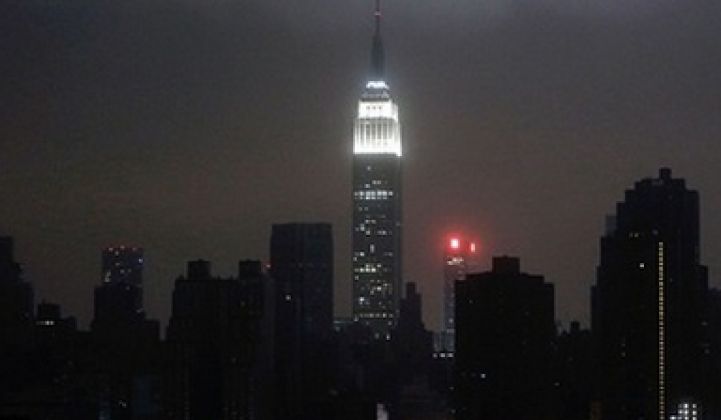Half of Manhattan went black after Hurricane Sandy overwhelmed a substation one year ago. There were a few bright spots of self-contained systems, such as the Goldman Sachs building and New York University’s downtown campus. But Manhattan was relatively lucky. Most of the lights came on within days. Not so for pockets of outer boroughs, Long Island and New Jersey, where outages stretched on for weeks. In some places, there was no neighborhood left to clamor for power service.
A year later, the utilities that suffered the most damage and the longest outages have been taken to task by politicians and regulators. The starkest example is Long Island Power Authority, which was stripped down, privatized and will now be run by PSE&G. The other utilities may still be intact, but they will not be the same in a post-Sandy world. Here are three ways in which Superstorm Sandy has changed the most affected utilities -- and maybe many more -- into the future.
1. Resiliency as a new business model. Utilities (and their regulators) have always prioritized safe, reliable, affordable electricity. Increasing superstorms are making utilities redefine reliability as resiliency. Resiliency is more than just flipping the switch and having the lights come on. Resiliency is the defining characteristic of an adaptable, flexible grid. It includes physical hardening such as higher floodwalls and more metal utility poles. But it is also a smarter, modern grid that can isolate outages, automatically let customers know when power is out and when it will be restored, and help first responders coordinate using IT.
Public Service Electric & Gas in New Jersey, ConEd in New York, and PPL in Pennsylvania are spending nearly $9 billion combined in response to Sandy. Regulators across the country are looking at novel ways for utilities to be able to invest in resiliency while still paying shareholders, such as using energy efficiency to offset the spending. Regulators and politicians are not just handing the purse to utilities; New York’s Governor Cuomo and New York City have reportedly come out against a rate hike for ConEd’s $1 billion resiliency plan. The impact of Sandy is finally bringing a broken regulatory and rate recovery system to light, and states are responding.
2. Microgrids. If only I had a dollar for every time someone mentioned microgrids as an obvious solution to outages. But true microgrids are expensive -- really expensive. In the wake of Sandy, New York’s Green Bank will likely include more money for combined heat and power systems, which have the potential to operate during grid outages, as one did at New York University. Sergej Mahnovski, director of the New York City Mayor’s Office of Long Term Planning and Sustainability, said at a recent event that his office was evaluating parts of the city that lend themselves to serving as “natural microgrids” such as Hospital Alley, a string of hospitals on the east side of Manhattan. “But we’ve only scratched the surface at this point,” he said at a Clean Energy Connections event. “We’re seeing a tremendous period of innovation right now.”
Microgrids, however, are not the same as distributed generation. While fully planned microgrids can island during a storm, distributed renewable generations such as rooftop residential solar are not necessarily an asset during an outage because they are taken offline by the utility so they don’t send power back down the lines. “We just don’t have the regulatory tools right now,” Mahnovski said of microgrids -- but there are calls to change that. They also might not necessarily be renewable, as CHP systems are usually powered by natural gas. Microgrids are coming, just not at the speed some would like.
3. Cooperation and Coordination. A recent report by the GridWise Alliance outlined five recommendations to help utilities increase their resiliency and response to storms. Some of the most important recommendations were not about burying wires or raising infrastructure; they were about improving communication and coordination both within the utility and with other key stakeholders, such as first responders.
One part of the process is integrating systems, so a tweeted picture of a downed wire could make it to every silo of the organization that could leverage it for better response -- from a customer service agent thanking the person on Twitter to the information going directly into the utility’s outage management system.
Another issue is enhanced emergency response planning, both within the utility and when bringing in outside crews. IT companies like IBM and Space-Time Insight are working on sophisticated planning algorithms that can help model storms so that utilities can plan for the right types of crews they will need and determine where to stage personnel. The GridWise Alliance has asked NIST to step in and develop interoperability standards for key utility systems, so crews from various utilities can work seamlessly together during disasters to cut outage times significantly.
Although the concept of resiliency as a driving force for infrastructure upgrades came after Sandy hit the mid-Atlantic, it has echoed across the country. In other regions, resiliency might include a more diversified, distributed power supply, including more renewables. "Resiliency" was the word PJM used to describe its recent investment in an additional $1.2 billion in transmission upgrades as coal-fired plants retire. "We have to fundamentally rethink the functions the grid should perform,” Thomas Bourgeois, director at the U.S. Department of Energy’s Northeast Clean Energy Center said at the Clean Energy Connections event in New York. Resiliency itself is not a definitive answer, but it should be a question: resilient against what?



